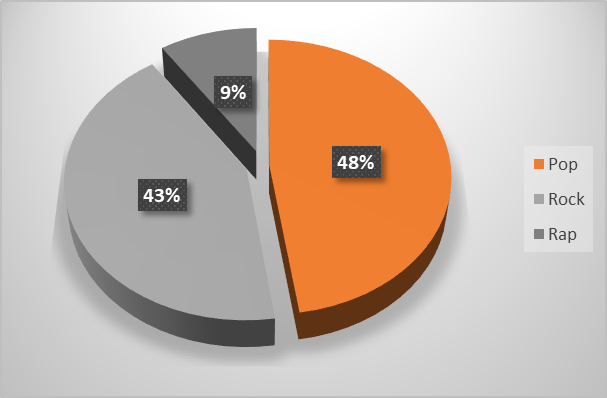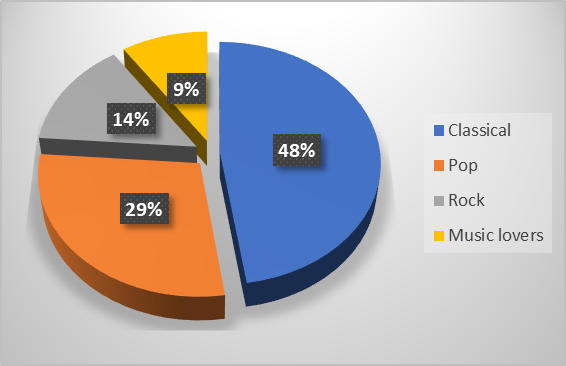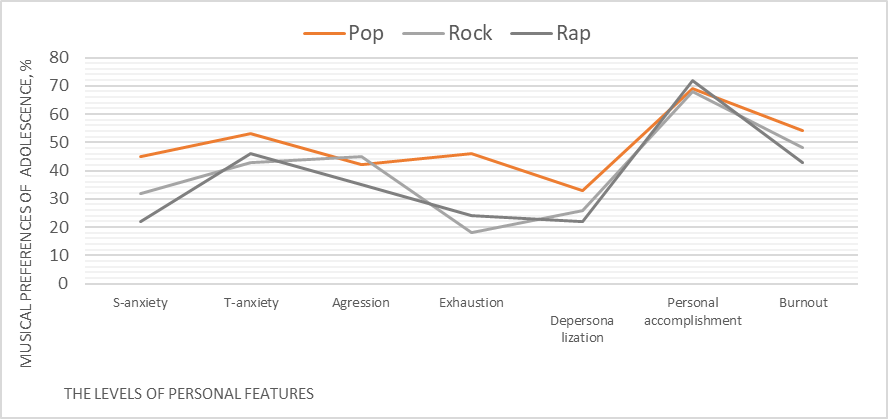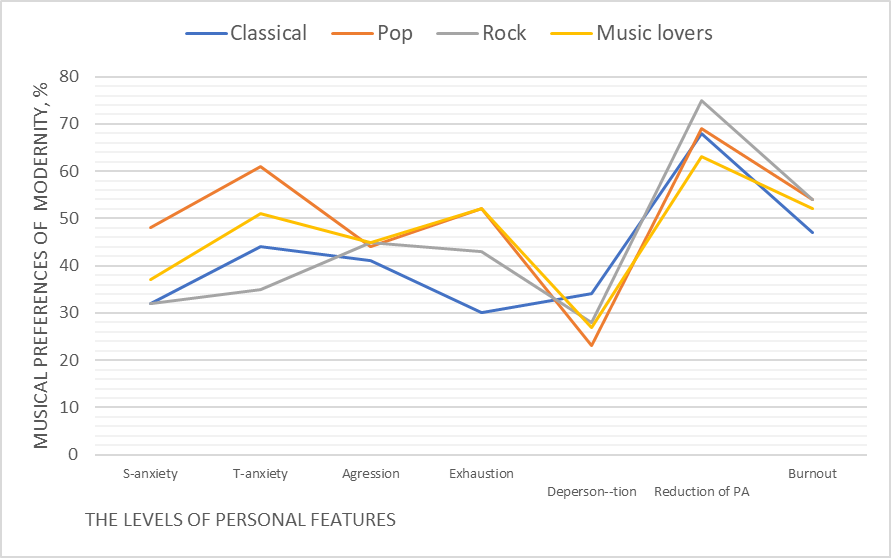Abstract
The present article researches the relationship of personal preferences and precedential musical phenomena of generation Y with the display of personal features such as emotional burnout, state & trait anxiety and aggression. Musical genres and trends are considered as precedential musical phenomenon revealed empirically during the self-analysis by the subjects that has the greatest impact on Generation Y. The empirical (pilot) study is based on a mixed methodology of psychometric and psychographic study of personal traits (anxiety and emotional burnout testing), precedential musical texts of recipients in their teens (retroanalysis), and actual musical preferences students of faculty of musical art. Preliminary data were obtained about significant relationships between the personal characteristics of students of generation Y and their musical preferences in adolescence and modernity. Those listeners who prefer rock music in their teens are less prone to “emotional exhaustion”, which can be explained as a resource found by this group for emotional energy gain or conservation balance. In adulthood listeners with a low level of emotional exhaustion prefer classical music. The level of exhaustion was high for the so-called "music lovers" and those who prefer pop music in their youth and modernity. This can be interpreted as the fact that music in their life did not become a channel of emotional “drainage” and a resource. A high level of anxiety was also demonstrated by respondents long-life listening to pop music. A low level of situational anxiety was shown by listeners of classical and rock music.
Keywords: Aggressionemotional burnoutemotional exhaustiongeneration Yprecedential musical phenomenontrait anxiety
Introduction
The relevance of the present study for contemporary art pedagogy is due to the investigation on the generation characteristics on the subjects of educational process alongside their individual psychological features analysis. This is an investigation on the subject as a representative of a certain generation, sharing the time of his/her existence and development with others, and brought together by the common signs-symbolic space. In our opinion generations produce their own images of the epoch and characteristics of the desired future expressed in the verbal and non-verbal cultural texts including musical ones. The study of musical “texts” in the conception of musical-psychological anthropology by Toropova (2015; 2014; 2019) is the research of material and ideal artifacts. That starts with a text fixing sound of music recorded in the graphic symbols generated by cultures up to musical practices and significant events as intangible “texts of culture”. It enables identify the leading values and symbols in the experienced content by both individual ethnical and social communities and by the whole generations. In this case our research interest is aimed at the following issue. What way and what musical phenomena the common generation values was transferred in and psychological resources of the person developed into overcome challenges (of growing and learning)?
An answer to the question and the solution of the problem under study is based on the extrapolation of such concepts as generation Y, the precedential text and the precedential phenomenon in the field of musical-psychological anthropology.
Problem Statement
The current situation for some period has been characterized as a situation of uncertainty: the features of which include emotional burnout, anxiety and aggression (Asmolov, 2018a; 2018b), which only intensified in the last few months of the global pandemic. At the same time we know very little about how generation Y lives this time and how it can be associated with psychological qualities that help or interfere with situations of uncertainty, those forms of musical activity that the whole generation prefers and shares with each other. It is especially important to study the influence of music in the context of modern pedagogical challenges.
Generation Y (millennials) are the people born from the year of 1980 till 2000. The theory of generation was created by Strauss and Howe (1991; 1997) and we used the classification of generation by Harris (2017).
According to Karaulov (2010) precedential texts are those: (1) significant cognitively and emotionally for one or the other person, (2) of a transpersonal nature, i.e. well-known to the wider environment of the person including his or her predecessors and contemporaries, (3) and finally, their usage is repeatedly proceeded in the discourse of the language personality (p. 216). A significant step in the study of the theory of precedent is the consideration of the concept of “precedential phenomenon” by Bagaeva et al. (1997). This concept includes a precedential text, situation, statement and a name. According to Nemirova (2012) in the text precedential phenomena reflect national cultural traditions in the evaluation and perception of historical events and persons, mythology, monuments of art, literature and works of the folklore. The precedential phenomena can be both verbal and non-verbal. We may include works of art, architecture and music in the latter. The necessity to introduce the concept of a “precedential musical phenomenon” is due to the fact that musical preferences represent the individual choice of the subject at the present time. Precedential phenomena form common ideals and values of the generation and attend in the common psychological past.
In present time at the scientific school of Moscow Pedagogical State University (leading professor A.V. Toropova) is creating the interdisciplinary research project “Musical-psychological anthropology” as a scientific field that allows comprehending the history of musical art and ethno-cultural variations of musical traditions, historical and modern musical styles as a representation of the experience of developing consciousness and expressing the key experiences of humanity. That forms the mentality, psychological needs and values of a particular social or ethnic group. The development of the methodology of musical and psychological anthropology makes it possible to study such phenomena as psychological identity of a certain culture or subculture, psychological roots of musical preferences and inclinations, musical style as the presentation of a “modal personality” of a certain social group or subculture, etc. The data obtained made it possible to make a generalization that the difference of society according to the types of musical preferences manifests deeper psychological complexes of life positions and anthropological images of virtual communities of people with different ideas about the main values of life and the meaning of life (Toropova, 2019). The research of the connection between individual and psychological features of personality and musical preferences was made by such authors as Mulligan (2009), Greenberg et al. (2015), Kuznetsova (2017), Grigoryeva (2014), Vershinin et al. (2016). At the same time we don’t have the study of personal characteristics relationship with those musical works and phenomena which preferred. These preferences are shared by many representatives of generations, they are precedential musical texts or phenomena. We believe that filling this gap could bring us closer to understanding the anthropological functions of musical phenomena which preferred or generated by each generation as a way of meaningfully filling the modal personality of generations or individual social groups.
Research Questions
The question that we posed in this study conducted on ignorance of whether there is a relationship between personal characteristics of the representatives of the generation and its preferred and precedential musical phenomena:
Is there a relationship between groups with shared case-law musical texts within the same generation and personal traits of groups’ representatives such as emotional burnout, state, trait anxiety and aggression?
The study was conducted on the example of generation Y.
Purpose of the Study
Objective of our study is to investigate the interconnection of precedential musical phenomena with such personal displays as emotional burnout, state, trait anxiety and aggression.
Research Methods
The experimental study of musical precedential phenomena and their contribution to the personal features as resources of the future teacher was carried out on the basis of Moscow Pedagogical State University. We employed the method of the historical-generational analysis of the interrelation of personal characteristics and preferred musical phenomena as precedential texts of generations. The sample consisted of 5-year students of Music Department. Many of them had already begun their professional career (n = 21).
During our experimental study it was made an attempt to investigate the interconnection of precedential musical phenomena with such personal displays as emotional burnout, state, trait anxiety and aggression. Musical genres and trends identified empirically during the self-analysis by the subjects were considered as precedential musical phenomena which had the greatest impact on Generation Y.
At the first stage the study included the identification of precedential musical phenomenon among the representatives of generation Y. The experimental group consisted of 21 bachelor of the music education born between 1989 and 1997 at the average age of 24 years old. The students filled in the questionnaire on precedential texts based on the existing questionnaires but aimed at music and were approbated within this research. Two key questions revealing precedential musical phenomena sounded as follows: “Write down your favourite musical work during your maturation and indicate your preferred musical trend for listening now”. It was discovered that in adolescence the subjects listened to such genres as pop, rock and rap. Nowadays they preferred classics, pop and rock. Two students considered themselves music lovers. The total example was differentiated by the “music” criterion based on the students’ responses. It should be noted that only two areas are the same in adolescence and modernity: pop and rock. In youth the subjects listened to rap, and in adulthood – classical music, two persons became music lovers (Figure


The students filled the “Professional (Emotional) Burnout” inventory worked out on the basis of three-factor model by Ch. Maslach and S. Jackson and adapted by Vodopyanova and Starchenkova (2008).
The following questionnaire was employed to diagnose the degree of state anxiety (S-anxiety) and trait anxiety (T-anxiety): 1) the State-Trait Anxiety Inventory (STAI) by Ch.D. Spielberger adapted by Yu.L. Khanin (Manual by Karelin, 2006). It has two types of anxiety: state (or situational) and trait (or personality). We tried to understand how musical preferences can connect with the level of different types of anxiety; 2) test for assessing the degree of aggression by L.G. Pochebut (Manual by Platonov, 2003). Manifestation of aggressive behavior by the test L.G. Pochebut is divided into 5 scales, but here we bring only general level of aggression. It consists from verbal, physical, emotional, subject and self-aggression.
The analysis of the results was carried out by means of the comparison of the groups with different musical preferences by the following criterion: emotional exhaustion, depersonalization, personal accomplishment, S-anxiety and T-anxiety, common level of aggression. (Statistical method - nonparametric Kruskal-Wallis H test).
Findings
Kruskal–Wallis H test confirmed the hypothesis about that the favourite musical trend during the maturation period is connected in no way with the level of any stage of the emotional burnout at the present. Thus, music tastes in adolescence did not lay the groundwork for higher indicators of the emotional burnout in the listeners of a certain trend. However the lowest average values on the “emotional exhaustion” scale were obtained in the students preferring rock. That result might help explain the psychological attachment of adolescents and young adults to this musical trend.
The questionnaire on precedential phenomena also included the question of the favourite music direction at the present time - preferences. As a result the total example was divided into four groups: listeners to classic music, pop, and rock, and those describing themselves as music lovers. The situation changed with regard to the level of emotional burnout on one of the scales. The Kruskal-Wallis H test value of 0.035 contributed to the rejection of the null hypothesis on the scale of “emotional exhaustion”. The relationship between the modern musical preferences of the subjects and the level of their professional burnout was identified. The students considering classical music to be their favourite musical direction had a low level of emotional exhaustion. The so-called music lovers and those subjects preferring pop music had a high level of exhaustion. The so-called "rockers" were in the middle.
With the help of mathematical data processing the interconnection of musical preferences at the level of anxiety was confirmed, but their influence on the level of aggression was not proved.
The students who listened to rock and rap music in adolescence had a moderate level of trait anxiety (T-anxiety), while the students who listened to pop music had a high level of T-anxiety. State anxiety (S-anxiety) was higher in the students who listened to pop music during their adolescence. That was confirmed by the Kruskal-Wallis H test value of 0.055 reaching the hypothesis rejection. The students who called rap their favourite direction had low average indices of S-anxiety corresponding to the moderate level. The “rockers" were in the middle (Figure

The Kruskal-Wallis H test value of 0.036 revealed the hypothesis deviation in terms of T-anxiety and the present preferred musical trends. High T-anxiety indices were detected in the listeners to pop music, the music lovers were in the second place. Low average group indicators of S-anxiety corresponding to the moderate level were inherent to those students who called classical and rock music as favorite directions; two music lovers found the moderate S-anxiety, and again the fans of pop music had a high level of S-anxiety. However, the deviation of the hypothesis on the S-anxiety was not detected. With regard to aggression the null hypothesis was not confirmed, no trends were revealed during the mathematical processing (Figure
These results were obtained on a small specifically professional example of 21 persons. It was necessary to pay the attention to that the subjects under test were students of the Music Department. If during their adolescence they listened to such musical directions as pop, rock and rap, then at present 10 persons going to become music teachers called classical music their favourite genre and two considered themselves music lovers. Thus, classical music became the precedential musical direction to them.

Among the musical directions affecting the subjects most, one could find the following styles: rock, pop and rap which were popular in youth subcultures at the beginning of the XXI century. It is noteworthy that the presence of the features of precedent in a musical work does not indicate its cultural significance and high aesthetic level. In this case, it is rather a matter of popularity and a strong impact on the consciousness and thinking of the listeners.
Conclusion
All of the above mentioned facts indicate a considerable and simultaneously hidden influence of music on the mental state of the subjects including the development of vitality and emotional satisfaction to overcome emotional burnout, anxiety and aggression. The questionnaire of precedential texts showed that music was significant in the cognitive and emotional aspects for the subjects. In adolescence music helped them cope with life challenges, and it also shaped their generation indirectly. The subjects under test told that in the youth music subcultures could give them new friends. Music often came into their life "from the yard”.
In the rapidly changing sociocultural conditions in which the representatives of generation Y were developed, there was a great number of musical layers and genres that could not be covered by one person’s consciousness. For that reason not one the best and not one the most talented musical patterns became precedential phenomena and texts but those that either sounded often in public places, television and radio. They were snatched by the minds of young people from the general stream as the most “useful” for the adaptation to the epoch and emerging challenges of that time. Over half of the students came to Moscow from other regions of Russia where they were able to discover concert halls, theatres with a diverse musical repertoire. Perhaps it was the influence of the big city that “reformatted” the musical tastes of the music department bachelors. In fact they studied classical music in childhood but they had less access to listening to its live performance.
Preliminary data were obtained (due to the fact that experimental studies were carried out with a limited sample) about significant relationships between the personal students’ characteristics of generation Y and their musical preferences in adolescence and modernity such as emotional exhaustion, personality anxiety (T-anxiety) and situational anxiety (S-anxiety). The music factor in our study turned out to be not connected with the aggression, which indirectly discredits the conventional wisdom about the particular aggression of certain musical communities representatives.
In accordance with the characteristics that showed a significant connection with the “musical” factor, the following generalizations can be made: those listeners who prefer rock music in their teens are less prone to “emotional exhaustion,” which can be explained as a resource found by this group for emotional energy gain or conservation balance. In adulthood listeners with a low level of emotional exhaustion prefer classical music. The level of exhaustion was high for the so-called "music lovers" and those who prefer pop music in their youth and modernity. This can be interpreted as the fact that music in their life did not become a channel of emotional “drainage” and a resource, but this is one of the elements of life with which they interact, while maintaining a tense state.
A high level of personality anxiety was also demonstrated by recipients long-life listening to pop music for, while a state of situational anxiety in present time was typical for listeners to pop music in teenage. A low level of situational anxiety was shown by listeners of classical and rock music.
We would like to emphasize the perspective of further investigations of the influence of music upon the development of generations. Filling the interdisciplinary field of musical-psychological anthropology with new facts, in turn, these investigations create the groundwork for designing the content of musical education taking into account the obtained scientific knowledge.
Acknowledgments
The authors are grateful to the Department of Methodology and Technologies in the Music Education Pedagogy in Moscow Pedagogical State University for the opportunity to conduct experimental work with the students.
References
- Asmolov, A. G. (2018a). Psikhologiia sovremennosti: vyzovy neopredelennosti, slozhnosti i raznoobraziia [Psychology of Changes: The Challenges of Uncertainty, Complexity and Diversity]. In A.G. Asmolov (Ed.), Mobilis in mobili: lichnostʹ v epokhu peremen [Mobilis in mobili: The psychology of changes] (pp. 13-26). Languages of Slavic cultures. [in Rus.]
- Asmolov, A. G. (2018b). Metodologiia psikhologii peremen: remeslo i iskusstvo somneniia [The Methodology of Psychology of Changes: The Mastery and Craft of Doubt]. In A. G. Asmolov (Ed.), Mobilis in mobili: lichnostʹ v epokhu peremen [Mobilis in mobili: The psychology of changes] (pp. 9-12). Languages of Slavic cultures. [in Rus.]
- Bagaeva, D. V., Gudkov, D. B., Zakharenko, I. V., & Krasnykh, V. V. (1997). Kognitivnaia baza i pretsedentnye fenomeny v sisteme drugikh edinits i v kommunikatsii [Cognitive Base and Precedential Phenomena in the System of Other Units and in the Communication]. Vestnik Moskovskogo universiteta [The Moscow University Bulletin], Series 9, Philology, 3(9), 62-75. https://istina.msu.ru/publications/article/3245012/ [in Rus.]
- Greenberg, D. M., Baron-Cohen, S., Stillwell, D. J., Kosinski, M., & Rentfrow, P. J. (2015). Musical Preferences are linked to cognitive styles. PLoS ONE, 10(7), e0131151. https://doi.org/10.1371/journal.pone.0131151
- Grigoryeva, O. Yu. (2014). Muzykal'nye predpochteniya v molodezhnoj srede [Musical preferences young adults]. Youth bulletin St. Petersburg State University of Culture and Arts, 1(3), 166-167. [in Rus.]
- Harris, M. (2017). Kids These Days. Little, Brown and Company.
- Karaulov, Y. N. (2010). Russkii iazyk i iazykovaia lichnostʹ [The Russian language and language personality] (7th ed). LKI Publisher. [in Rus.]
- Karelin, A. (2006). Bolʹshaia entsiklopediia psikhologicheskikh testov [Big encyclopaedia of psychological tests]. Eksmo. [in Rus.]
- Kuznetsova, E. P. (2017). Issledovaniya muzykal'nyh predpochtenij molodezhi [Studying young peoples’ musical preferences]. Manuscript, 9(83), 115-118. [in Rus.]
- Mulligan, T. P. (2009). The relationship of music preference and music function with coping in university students (Doctoral dissertation). Oklahoma State University.
- Nemirova, N. V. (2012). Precedentnye fenomeny kak reprezentanty konceptov v russkoj yazykovoj kartine mira [Precedential phenomena as the representatives of the concepts in the Russian language picture of the world]. Questions of cognitive linguistics, 4, 31-36. [in Rus.]
- Platonov, Y. P. (2003). Osnovy etnicheskoj psihologii. Uchebnoe posobie [Basics of ethnic psychology. Training allowance]. Rech’ [in Rus.]
- Strauss, W., & Howe, N. (1991). Generations: The History of America's Future 1584 to 2069. William Morrow.
- Strauss, W., & Howe, N. (1997). The Fourth Turning: An American Prophecy — What the Cycles of History Tell Us About America’s Next Rendezvous with Destiny. Broadway Books.
- Toropova, A. V. (2014). Fenomen intonirovaniya kak antropologicheskij orientir sohraneniya i vosproizvedeniya oblika cheloveka opredelennoj kul'tury [The phenomenon of intonation as an anthropological reference point for the preservation and reproduction of a person’s image of a certain culture]. The Bulletin of “St. Tikhons University for the Humanities”, Series 4: Pedagogy and Psychology, 3(34), 72-84. [in Rus.]
- Toropova, A. V. (2015). Znakovaya funkciya muzykal'nogo intonirovaniya kak otrazhenie mifologiki soznaniya (k voprosu o psihologicheskih osnovaniyah pedagogiki muzykal'nogo obrazovaniya) [Sign Function of Musical Intonation as а Reflection of the Mythologies of Consciousness (To the Issue of the Psychological Foundations of the Music Education)]. The Bulletin of the UNESCO Chair “Musical Art and Education”, 4(12), 39-52. [in Rus.]
- Toropova, A. V. (2019). Muzykal'no-psihologicheskaya antropologiya kak mezhdisciplinarnaya oblast' nauchnyh znanij [Musical-Psychological Anthropology as an Interdisciplinary Field of Scientific Knowledge]. The Bulletin of the UNESCO Chair “Musical Art and Education”, 2(12), 24-40. [in Rus.]
- Vershinin, A., Holodov, Y., & Bogatyreva, Z. V. (2016). Muzykal'nye predpochteniya studencheskoj molodezhi [Musical preferences of students]. Mezhdunarodnyj studencheskij nauchnyj vestnik [Iinternational student research bulletin], 5(1), 12-15. [in Rus.]
- Vodopyanova, N. Y., & Starchenkova, Y. S. (2008). Sindrom vygoraniya. Diagnostika i profilaktika 2-e izd [The burnout syndrome. Diagnosis and prevention]. Peter. [in Rus.]
Copyright information

This work is licensed under a Creative Commons Attribution-NonCommercial-NoDerivatives 4.0 International License.
About this article
Publication Date
18 December 2020
Article Doi
eBook ISBN
978-1-80296-097-6
Publisher
European Publisher
Volume
98
Print ISBN (optional)
-
Edition Number
1st Edition
Pages
1-788
Subjects
Communication, education, educational equipment, educational technology, computer-aided learning (CAL), Study skills, learning skills, ICT
Cite this article as:
Toropova, A. V., & Kharzhevskaia, A. A. (2020). Relationship Of Preferred Musical Phenomena Of The Generation With Their Personal Characteristics. In O. D. Shipunova, & D. S. Bylieva (Eds.), Professional Culture of the Specialist of the Future & Communicative Strategies of Information Society, vol 98. European Proceedings of Social and Behavioural Sciences (pp. 453-461). European Publisher. https://doi.org/10.15405/epsbs.2020.12.03.45

